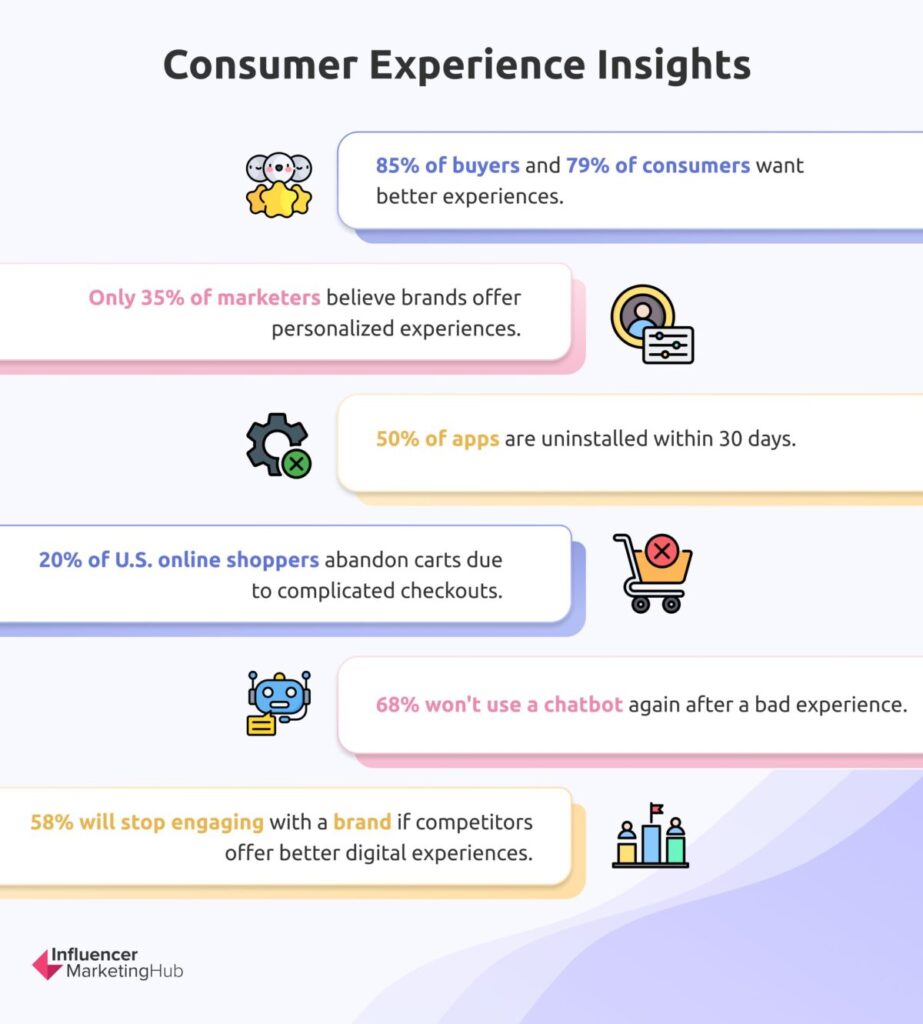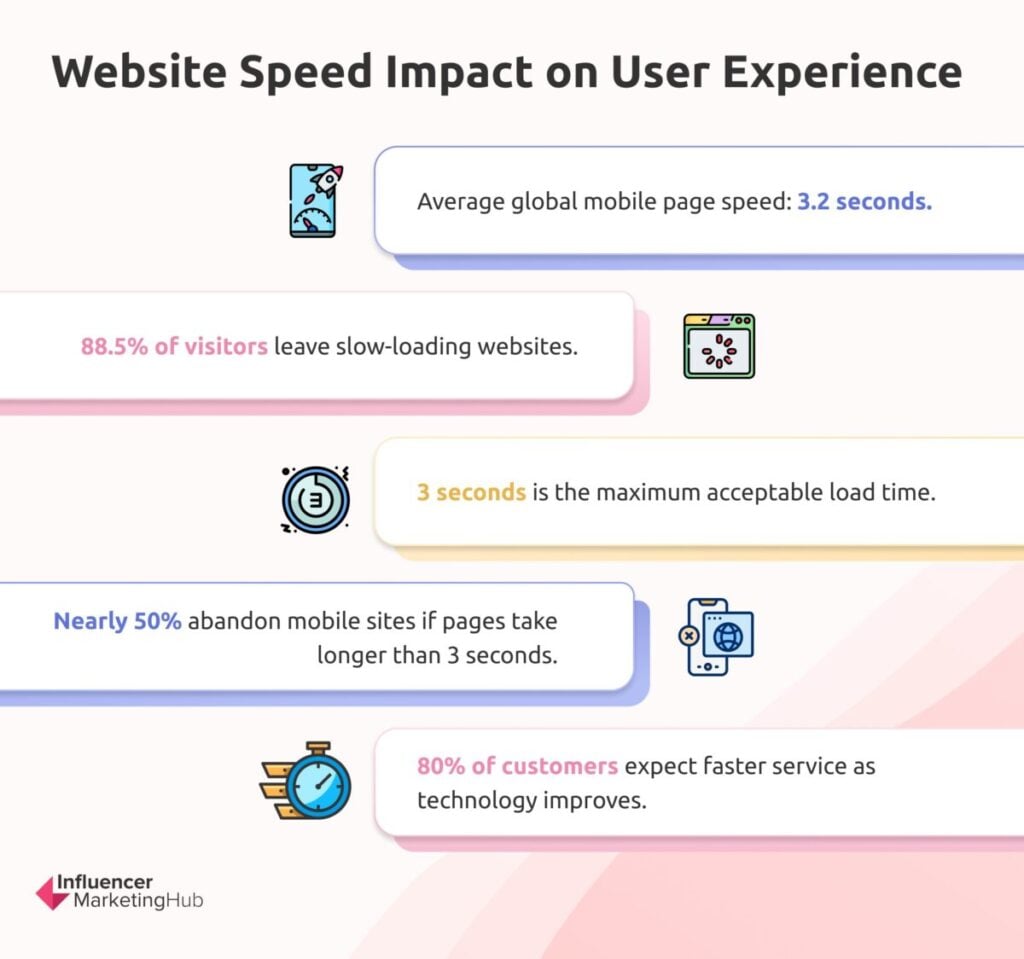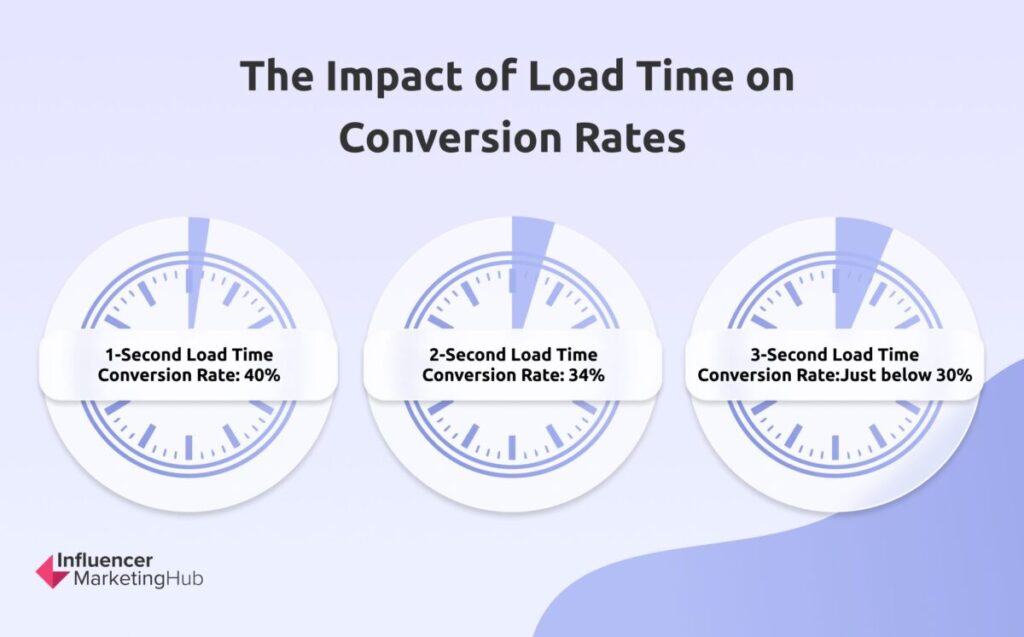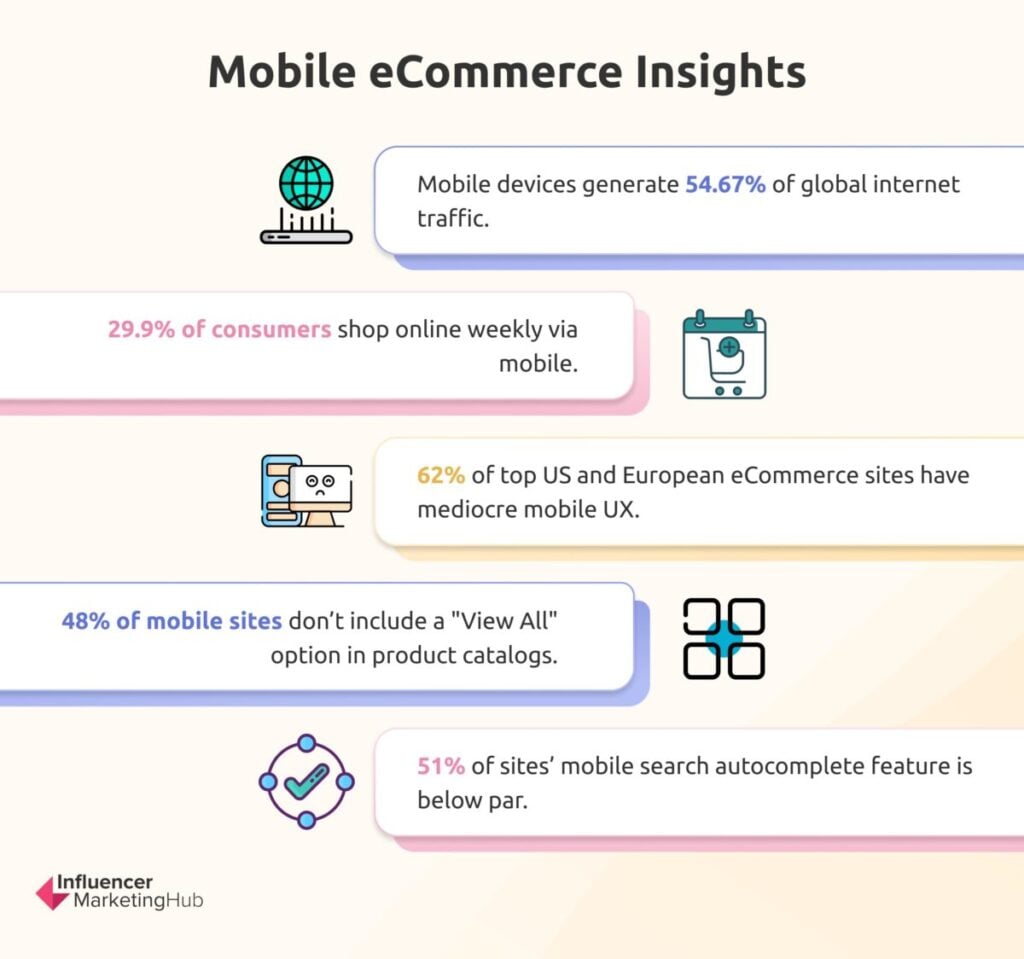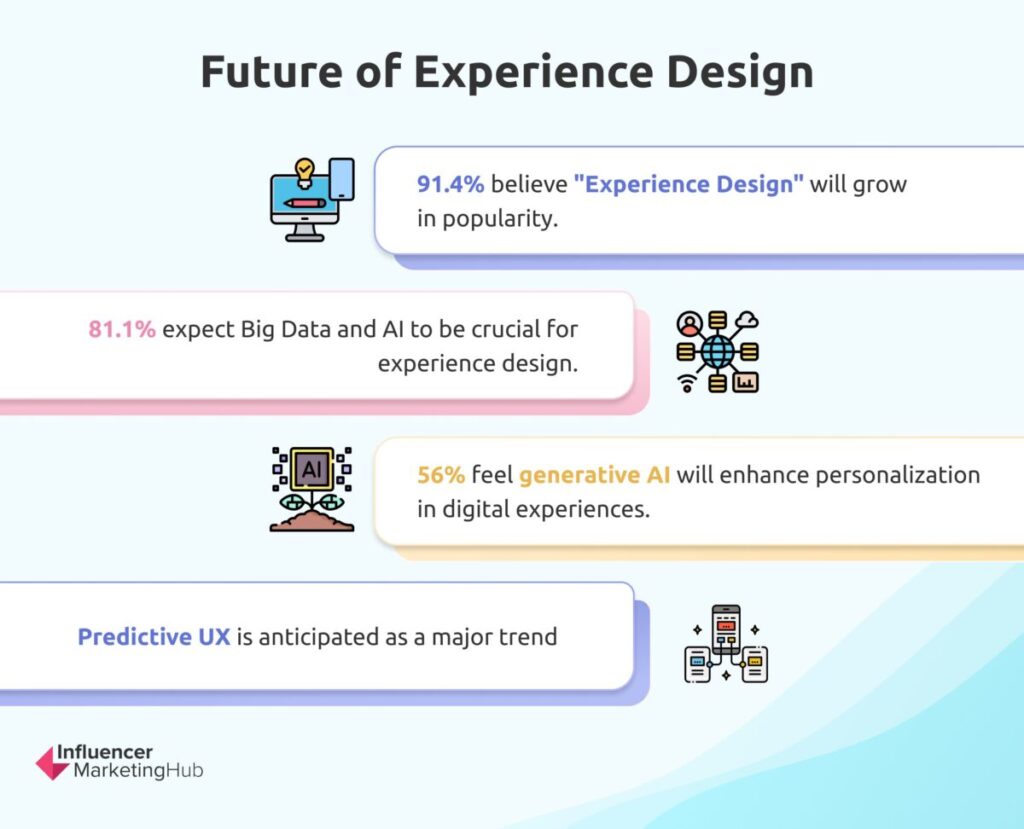When creating eCommerce sites and apps, user experience tends to be just an afterthought-something that is nice to have, not something that is essential. But with consumers placing more value on their experiences throughout their buyer journeys, UX should be at the core of web and app development.
However, some stakeholders and investors might need some convincing for them to see why UX is worth the investment. So, we have collated statistics that underscore the importance of good UX by giving us a glimpse of its impact on businesses. These numbers indicate the possible implications of neglecting UX and the potential for growth it brings to businesses that understand its true value.
- Impact of UX on Conversions and Revenue Statistics
- Cost of User Frustration and Bad User Experiences
- First Impressions and User Retention Statistics
- Speed and Performance Impact on User Experience
- Stats on UX Best Practices
- Mobile UX Statistics
- Ecommerce UX Statistics
- Stats on ROI and Business Impact of UX
- Emerging Trends and the Future of UX
- Great UX Paves the Way for Business Success
- Frequently Asked Questions
Impact of UX on Conversions and Revenue Statistics
The demand for better user experiences is not confined to specific segments or geographical locations. With eCommerce growth still steadily seen worldwide, the need for UX spans borders and other demographics. Global research and surveys support the growing need for businesses to pay more attention to their UX design. As James Weiss, Managing Director at Big Drop Inc., explains:
“Re-envisioning user experience can absolutely have a direct impact on business outcomes. The most obvious example is understanding that proper call-to-action (CTA) placement is the difference between having a website and having a website that is optimized for conversion. Moreover, serving an intuitive pathway for users to arrive at the resources they want or actions they need to take reduces the likelihood of confusion, and essentially, conversion apprehension.”
- About 75% of marketers believe that a personalized experience boosts sales and the chance that a contact will become a repeat customer. (HubSpot)
- 53% have a dedicated customer experience budget. (Adobe)
- About a third of experts across industries expect the budget for “Experience Design” in their companies to increase this year. (UX Trends Report 2024)
- 80% of consumers agree that the experience a company provides is as important as its products and services. (Salesforce)
- Companies that have made customer experience a top priority have increased the rate of repeat business by 12%, the referral rate by 17%, and new customer acquisition by 23%. (Adobe)
Cost of User Frustration and Bad User Experiences
Slow loading times, confusing navigation, limited accessibility, and other poor UX features lead to user frustration. Constant frustration leads to customer churn that impacts the bottom line. In fact, billions of dollars are lost by businesses due to poor UX. Let these statistics warn you of what could happen if UX is not given the attention it deserves.
- Considering all the data companies collect, 85% of business buyers and 79% of consumers feel customer experiences should be better. (Salesforce)
- Only 35% of marketers think that brands are currently offering customers a very personalized experience. (HubSpot)
- 1 in 2 apps installed are uninstalled within 30 days. (AppsFlyer)
- Just over 20% of online shoppers in the U.S. abandon their shopping carts due to an overly long or complicated checkout process. (Baymard Institute)
- 68% wouldn’t use a company’s chatbot again if they had a bad experience. (Salesforce’s State of the Connected Customer report)
- 58% of customers will stop interacting with a brand if a competing brand offers a superior digital experience. (Adobe)
- For SaaS companies, issues with changing, pausing, or canceling subscriptions can cause 60% of subscribers to stop using their services. (Adobe)
- After product quality and deals, customer experience is the leading reason why customers will switch to another brand with 58% citing it as their top motivator. (Statista)
First Impressions and User Retention Statistics
Website design and its user experience play a critical role in creating positive first impressions. Aside from influencing brand credibility, it also plays a role in retaining users helping to improve customer loyalty. These stats show how good design can improve the user experience and grow your base of loyal customers.
- Nearly four out of 10 website visitors will leave a website if it has an outdated design. (GoodFirms)
- 29% of customers feel that the initial searching/discovery stage has the most impact on their impression of the overall experience. (Adobe)
- 96% of marketers feel that highly personalized experiences improve the likelihood that a buyer will become a repeat customer. (HubSpot)
- While first impressions matter, consistency matters too. Delivering a consistent customer experience (and high-quality customer service) will help 76% to build trust in a company. (PwC’s Voice of the Consumer Survey 2024)
For Brigitte Gillis, Director of Product at White Glove, it’s all about placing the user at the center of your design process, which has helped her to improve retention. She explains:
“I prioritize a user-centered approach in my design process. This means understanding user needs through research and continuously iterating based on their feedback. This translates to interfaces that are intuitive and easy to navigate, with clear information architecture and engaging interactions. Ultimately, this keeps users happy and coming back for more.”
Speed and Performance Impact on User Experience
The overall website performance, specifically the page load speed, has such a significant impact on the user experience that it deserves its own section. Here are stats that show you just how big of an effect it can have on key digital marketing metrics like your bounce rate and conversion.
- The average page speed globally is 3.2 seconds to load on mobile devices and 2.8 seconds to load on desktops. (Illustrate Digital)
- Based on the average website speed in 2023, the average Gen Z internet user would’ve wasted 31.5 days waiting for websites to load. (Illustrate Digital)
- Poor website speed is the top reason why a website visitor will leave a website. Nearly 90% (88.5%) of visitors indicated that they would leave a slow-loading website. (GoodFirms)
- If a website takes longer than 3 seconds to load, users have more than likely already become frustrated and will leave the website. As such, 3 seconds signifies the maximum acceptable wait time for website visitors before they consider abandoning a site. (Atomic Digital Marketing)
- Nearly half of all website visitors will leave a mobile website if the pages don’t load within 3 seconds. (Google)
- A website that loads in only 1 second has a conversion rate has an average conversion rate of nearly 40%. That’s 3 times higher than one that takes 5 seconds to load. (Portent)
- When a page loads in 2 seconds, it has an average conversion rate of 34%. (Portent)
- When a page loads in 3 seconds, its average conversion rate drops to just below 30%. (Portent)
- About 80% of customers expect faster service when technology advances. (Salesforce)
The good news is that there are several tweaks that you can do that will improve your website speed. These include simpler strategies like compressing your images and selecting the right image format, to more complex tasks such as minifying your code.
For example, Jabez Tadesse, founder and webmaster at Xrilion, improved his page speed score of 72 to an impressive 98-100 page speed score on Google with the help of a small, efficient team based in the Netherlands. He explains that they achieved these results (and within less than two weeks) as follows:
“They removed unnecessary elements, rewrote and restructured some code, and implemented the latest technologies. Great!
However, a significant challenge arose when they recommended removing an entire library I was using. They made it clear why and I was convinced. This meant I had to rewrite several scripts from scratch.”
Stats on UX Best Practices
If you’re all set on transforming your UX, here are stats that can help you craft a strategy for designing, developing, and implementing a user experience tailor-fit to your organization’s needs.
- 78% of businesses use customer data management tools to support customer experience. (Adobe)
- 48% of organizations have integrated predictive analytics into their customer experience efforts. (Adobe)
- 46% of customers feel that personalization has made their positive experience memorable. (Adobe)
- More than 70% of web designers use Photoshop, Illustrator, and Sketch. Photoshop is the most popular of these UI/UX tools with 88.5% using it. (GoodFirms)
- Flat design and expressive typography are two of the top trends in web design with 88.5% and 61.5% of web designers respectively leaning towards these trends. (GoodFirms)
For Garry West, Creative Director at Imagefix, kinetic typography is one of the top web design trends that brands should be aware of in 2024. He explains:
“Kinetic typography animates text in a novel or witty way in order to grab the attention of users and help guide them through the content.”
Mobile UX Statistics
We’ve reached a point where mobile devices drive more traffic than desktops. In fact, Jabez Tadesse from Xrilion recommends that we prioritize mobile devices. He explains:
“Mobile-first development has become an industry standard. This approach involves designing for mobile devices first, then adapting the design for desktop use.
Plus, actions aren’t limited to casual browsing. Mobile commerce is also picking up, underscoring the need for proper UX mobile design (which many businesses can still improve on) as these stats show.”
- Mobile devices generate 54.67% of global internet traffic, underscoring the need to design for mobile. (Statista)
- Revenue from mobile eCommerce sales added up to about $1.7 trillion in 2023, more than half of all retail eCommerce sales. (Statista)
- As of Q3 2023, about a third of consumers (29.9%) bought something online each week via a mobile device. (Statista)
- The conversion rate for eCommerce websites for tablet devices was 3.1 in 2023, slightly higher than for desktops. (Statista)
- 11% of marketers feel that mobile-friendly websites have generated strong results. (HubSpot)
- The mobile UX performance for 62% of the average top-grossing US and European eCommerce websites is rated as mediocre, while for 38% it’s decent. (Baymard Institute)
- Only 1.5% of the average top-grossing US and European eCommerce websites’ mobile UX performance is rated as poor. It’s a huge improvement from 2022 when 9% of these websites were regarded as offering a poor mobile UX performance. (Baymard Institute)
- 74% of mobile sites don’t offer enough white space between clickable elements. (Baymard Institute)
- Nearly half of mobile websites (48%) don’t offer a “View All” option at the different product catalog levels. (Baymard Institute)
- 51% of sites’ mobile search autocomplete features are below par. (Baymard Institute)
- 57% of mobile sites don’t have direct links in the footer to information about shipping and returns. (Baymard Institute)
To help improve mobile UX, Chris Gibbins, CEO at Creative CX, shares this top tip:
“The single most important recommendation we'd make to teams out there is to conduct QA, UAT and also usability testing on actual REAL mobile devices. NOT on mobile emulators on their desktop. It's incredible how many issues we discover when carrying out our user research that were caused by no one checking that a design works properly on an actual real device.”
Ecommerce UX Statistics
As mentioned earlier, bad UX design can harm brand credibility. In the case of eCommerce businesses, it can also have a direct impact on sales. The following stats show the state of UX design in eCommerce and share suggestions for areas that can be improved.
- 52.6% feel that the eCommerce and retail industries will be looking for help with experience design in the coming years. (UX Trends Report 2024)
- 49% feel that the consistency of personalization between online and in-store experiences improved in the past three years. (Adobe)
- 94% of marketers feel that a highly personalized experience improves sales. (HubSpot)
- More than 70% of global online shoppers cited fees as the reason for abandoning their carts. About 41% failed to complete checkout because delivery fees were too high, with another 30% abandoning their items because of unexpected costs. While UX agencies can do little about delivery fees, they can ensure that all costs are clearly explained before checkout to eliminate surprises that can negatively impact conversion. (Statista)
- In the US, costs were also the main reason why consumers abandoned their orders during the checkout process. About a quarter also cited a complicated, long checkout process, even more so if they first need to create an account, as the reason why they don’t complete their order. The implication on eCommerce UX design is that the checkout process should be as smooth as possible. (Statista)
These stats show that paying specific attention to the checkout flow can have a massive positive impact on cart conversions as Brigitte Gillis from White Glove explains for Influencer Marketing Hub:
“In a previous role, we redesigned the checkout flow to address user pain points. This resulted in an increase of 27% in shopping cart conversions, demonstrating the direct impact of improved UX on business outcomes.”
Stats on ROI and Business Impact of UX
One design change or feature can generate (or cost) a business millions. If you’re still unconvinced about how UX can impact your business, consider the following results that Creative CX has generated as their CXO, Chris Gibbins explains:
“When we work with large brands whose websites drive millions of pounds of value per week, A/B testing and statistics play a crucial role in our web and app design decision-making process. Every design change or new feature has the potential to either increase or decrease conversion rates.
A/B testing is the only way to know with confidence whether the change is adding or losing millions for the company. For example a recent design change we made to improve the user experience (solving an identified problem) drove a £4 million improvement. And another feature we A/B tested, which was actually a so-called "no-brainer" idea the brand wanted to push through we discovered would have lost them £10 million+ if it was just rolled out as originally planned!”
Do you need to know more about the positive effects on customer satisfaction and business workflows? Here are stats that show the positive ROI of investing in UX. These show the significant business impact of user experience in companies across the globe.
- 59.6% feel that “Experience Design” has a very important impact on business performance, while 6.6% rate it as somewhat important. (UX Trends Report 2024)
- 46.2% use KPIs to measure the impact of “Experience Design” in their companies. (UX Trends Report 2024)
- The marketing teams of brands that manage to deliver a personalized experience to their customers are 215% more likely to say that their marketing strategy was effective in 2023. (HubSpot)
- When Staples redesigned their eCommerce site to enhance UX, they experienced an 80% increase in site visitors and a 67% increase in repeat customers. (Source)
- Implementing a customer experience transformation built on agile approaches, clear aspirations, and new capabilities yields 15 to 20% increases in sales conversion rates. (McKinsey)
- When Duck.Design’s team of designers created a strategy that focused on branding, UX/UI design and app UI/UX design, they managed to boost Ionise’s user adoption and user engagement by 25% and 45% respectively. (Duck.Design)
- When Pinch, a dating mobile app, redesigned its app’s UI/UX flow, it increased its retention rate by 430%. (Moburst)
- FLO managed to grow its active users by 10 million with Neuron’s award-winning iterative UX design that included reimagining the reporting features and designing a dashboard. (Neuron)
Emerging Trends and the Future of UX
As you would expect, artificial intelligence (AI) is one of the emerging trends that will impact the future of UX quite significantly. It will greatly impact personalization, according to Jabez Tadesse, Xrilion’s founder:
“AI is poised to revolutionize user experience through personalization. Major brands are already using AI to adapt to your preferences, anticipate your needs, and offer real-time suggestions.”
Micro-interactions and “emotional design” are two other emerging trends that he believes will shape the future of the industry.
The following statistics offer a closer look at how AI (and other trends) will impact the future of UX (and whether UX will still be relevant in the next few years).
- The vast majority (91.4%) feel that “Experience Design” will become more popular in the next decade. (UX Trends Report 2024)
- 42% of organizations have integrated machine learning into their customer experience efforts. (Adobe)
- To improve the experiences across the customer journey, 47% of businesses plan to break down organizational silos. (Adobe)
- Just over half (51.7%) feel that seamless experiences across multiple channels are the area that’s expected to have the biggest business impact in the coming years. (UX Trends Report 2024)
- 81.1% anticipate that Big Data and AI will be the most important areas for experienced design professionals in the next year. (UX Trends Report 2024)
- 56% of customers feel that generative AI will make digital experiences more personalized. (Adobe)
- 72% of marketers feel that AI and automation tools will help them to personalize the customer experience. (HubSpot)
- Seven out of 10 marketers that use AI and automation indicated that it helps them to improve the overall customer experience. (HubSpot)
- Predictive UX is expected to be the biggest trend in the coming year. (UX Trends Report 2024)
- 73% of business buyers and 51% of consumers are open to the use of AI if it will improve their experience. (Salesforce)
- About a quarter (23.1%) of web designers are leaning towards integrating voice user interfaces. (GoodFirms)
Great UX Paves the Way for Business Success
UX is not just an edge that gives your business a competitive advantage. It is now a core element in your business strategy that’ll pave the way for future success. Digital-savvy consumers expect brands to understand their needs and deliver the best user experiences possible across all channels.
Optimizing your UX design to meet the needs of your consumers will ultimately boost your revenues. For best results, partnering with UX/UI agencies can accelerate your transformation. With a better understanding of how UX impacts the different aspects of your business, stakeholders and investors are more likely to support allocating higher budgets for UX. Arm yourself with facts and figures to convince them further that UX is worth the investment.
Frequently Asked Questions
What is good UX?
Good UX optimizes the journeys of users across channels. It ensures that the right content and functionalities are given to users the right way in the right place and at the right time. For eCommerce sites, this includes providing users seamless and frictionless journeys throughout their buying process.
What happens when UX is bad?
Poor UX affects customer satisfaction, customer-brand relationships, and brand reputation among other things. When UX is bad, users tend to become frustrated and are less likely to engage with a brand again. If UX issues are not addressed, a brand not only loses loyal customers but also loses its reputation as a reliable company. The implications of bad user experiences can cause severe blows to businesses.
How can app experiences be improved for better UX?
With most consumers using mobile devices, brands must enhance the app experiences they offer. Some of the best ways to do this is by offering more personalized interactions and updating features to meet the ever changing needs of consumers. Also consider diversifying use cases to remain relevant as trends change.
Why is UX important?
User experience fosters relationships between users and brands. By ensuring that users are able to navigate through their site easily and complete transactions seamlessly, brands make their customers feel valued. It shows that they invest time and effort to make sure that users have a positive experience on their site. This then results in higher customer retention, increased brand loyalty, and greater revenues.
What are some concrete ways to improve UX?
Users have better experiences on well-designed and responsive sites that load fast. When designing your pages, avoid adding unnecessary elements that will just slow their loading times. Use fonts and colors that are readable and easy on the eyes. Create a structure that makes navigation smooth. Include a clear CTA on every page to guide users through their journey.
What are the most critical UX metrics to track for product improvement?
Good UX not only enhances user satisfaction but also boosts conversion rates and retention. To achieve this, you need to track metrics like: task success rate (TSR), engagement metrics like click-through rate (CTR), session duration, net promoter score (NPS), and daily/monthly active users.
How does UX impact customer retention rates?
Websites or apps that load quickly are more likely to retain users. Plus, if a user finds your platform easy to use, they’re more likely to return. This includes everything from well-placed call-to-action buttons to accessible content. Consistency in design elements like color schemes, typography, and button styles further helps to build trust in the brand which is needed to build strong customer relationships.
